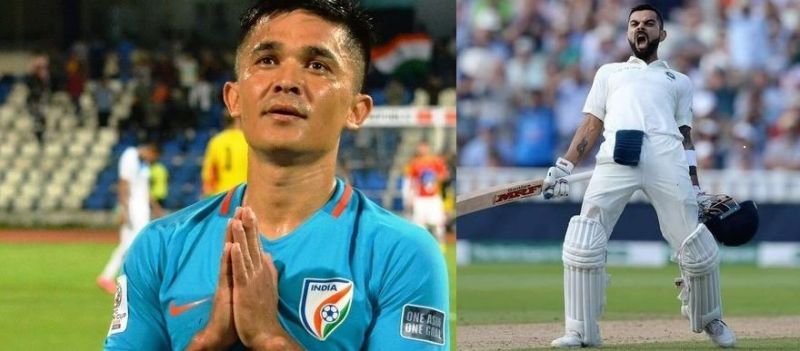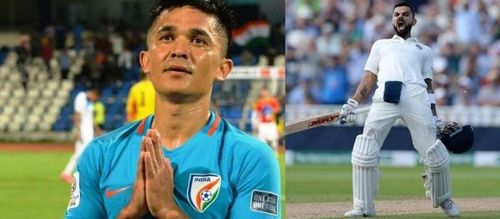
Virat Kohli and Sunil Chhetri - So similar, yet so different

It seems a good time to be writing this – what with one of them breaking a four-year-long wait for runs in England and the other celebrating his birthday today.
They are really two of the most adored sporting figures in this country. The levels and the magnitude of the adoration may be poles apart but India has always been a country that looks up to its heroes especially its sporting heroes.
But what makes Virat Kohli and Sunil Chhetri the heroes for India to adore? How much do they actually share in common when they get on to a sporting field?
Well, for starters, let’s get the obvious similarities out of the way. They both grew up in Delhi and they both have gone on to become captain of India and captain of a team from Bengaluru in their respective sports.
Virat Kohli and Sunil Chhetri are the same – their will and desire to win being almost second to none. The penchant to be the best they can be at all points, with no drop in intensity is second to none. Yet, they will never be seen as the same.
Let’s take one incident from the last few months for each of them and maybe that way, we can see the slightest of similarities. Bengaluru FC were taking on New Radiant SC from the Maldives in the group stages of the AFC Cup and it was a game that they had to win against their biggest challengers in the group, especially considering that it was a home game.
Chhetri did not start the game as coach Albert Roca decided that he needed a break after his exertions in the AFC Cup and the Super Cup, however, as fate would have it, Bengaluru needed their talisman. So, on he came in the 60th minute. The captain’s armband came from goalkeeper Lalthuammawia Ralte to go on the no.11’s arm, but back it went straight where it came from. The insignificant things didn’t matter as Chhetri was there to help Bengaluru win and the armband was not going to help him do so.
He was denied a stonewall penalty in the 82nd minute, but was he going stop? Of course, he wasn’t. He latched on to a through ball from midfield deep into injury time, and once he was clear of the defenders, one-on-one with the ‘keeper, a man of his talent and class could’ve easily dinked it over the advancing opponent, but right by him was Nishu Kumar in acres of space with an empty net in front of him. The ball went straight to Nishu’s feet as the captain let the youngster have his moment of glory. Bengaluru FC had won.
The bigger story from that night wasn’t that he came on as a substitute and won. If club officials are to be believed, Chhetri was fuming before the start of the game because he wanted to play – none of this resting business was going to appease him but the Spanish manager of Bengaluru had his way on that day.
His body could easily have done with the day off on that day, especially given it was in the middle of another tournament that Bengaluru were playing in the small matter of a 40-degree Odisha summer. But Chhetri wanted to win. Win at any cost. Win at maybe even the cost of his own health. By all accounts, Chhetri is a sore loser, the sorest loser some people within Bengaluru ranks have known, so you can understand his desire.
And truthfully, that is Virat Kohli to the T as well - the boy from West Delhi whose rise to prominence began in a time of immense personal grief. An 18-year-old playing for Delhi in one of his early Ranji Trophy games had tragedy striking when at the end of the 3rd day’s play, he had news delivered to him that his father was no more. But Kohli knew that Delhi needed him to come out the next day to bat and save the match against Karnataka. A match-saving 90 followed and India was given its first glimpse into Virat Kohli – the man who absolutely hated losing.
That was Virat Kohli on Day 2 at Edgbaston as well. His bowlers had bowled England out for 287. His openers gave India a solid, if unspectacular start, putting on 50 for the first wicket. But then came Sam Curran and Ben Stokes to reduce India to 100-5. In the middle of that, he himself was being tormented by the relentless skill of a 36-year-old warhorse named James Anderson.
But giving up and throwing his wicket away was never an option, not when Team India needed its captain to stand and be counted, not when Kohli himself was looking for some tape to put on mouths of naysayers, who had their guillotines out and sharpened, ready for what according to them, would be another inevitable low score in England.
But off he went on his rescue mission. He saw Hardik Pandya and Ravi Ashwin sent back to the pavilion by two beautiful deliveries and when Mohammad Shami joined him at 175-7, Kohli knew it was time for him to take centre-stage. The strike was farmed – Shami, Ishant Sharma and Umesh Yadav were cajoled into blocking as much as they could, just so that they could give their captain the opportunity to hurt England. And he hurt England. With his first century in the Old Blighty, Kohli brought India back from the dead and kept the Test match competitive.
So, we have two boys from Delhi, two captains of Bengaluru, two men who detest losing. But perhaps the greatest beauty of watching Kohli and Chhetri strut their stuff out in the middle is in watching them strut their stuff and revel in the beauty of how wonderfully contrasting it is.
Where the celebrations on the cricket field might sometimes include mic-drops, kisses, fingers on lips, and maybe a few now-trademark Kohli expletives, the celebrations on the football field barely extend beyond Chhetri’s folded hands and maybe sometimes a little kiss to an adoring missus in the stands.
Kohli revels in the battle, he feeds off the energy that confrontation brings him. When you needle Virat Kohli on the cricket field, a response won’t be too far away as Mitchell Johnson found out in Melbourne in 2014. A ball was hit straight back at the big Aussie fast bowler and as he flung it back towards the striker’s end, it caught Kohli on the back of his shin. That was enough to invigorate Kohli as Johnson was taken to task. He bowled full, he bowled short, he bowled wide, he bowled straight and yet, there was no answer to the ferocity of Kohli’s assault that day.
With Chhetri, you won’t see him in the heart of the battle as much. Yes, the odd confrontation – as Mehtab Hossain and Khalid Jamil found out - may still tickle his senses, but Chhetri doesn’t need that. When Chhetri is at his best is when he’s inconspicuous by his absence in all the shenanigans that usually come with football. When he’s at his best, all Sunil Chhetri is doing is talking to the round thing at his feet and telling it where to go, how to go there.
And then there’s the two of them as captains. Kohli is loud, you know it when he’s around and as many a journalist has found out over the past couple of years, he is not afraid to call them out even when there’s no wrong on their part. He’s not out there to make friends. But with Chhetri, what you get is a mellowed down, sometimes even quiet captain. He knows his job as captain is to make those around him feel comfortable and allow them the best environment to ensure consistent levels of performance on the field.
And yet, what defines both of them as captain is that they are the most wonderful examples of the most basic captaincy tenet, that is, the ability to lead by example, when the chips are down and when all the odds are against them.
India is blessed, blessed by two Delhi boys who have made the motherland proud on more than one occasion. They’ve made the motherland proud in their own way, so different and yet, the very same. For Sunil Chhetri and Virat Kohli, to win games for their country just couldn’t come more naturally.